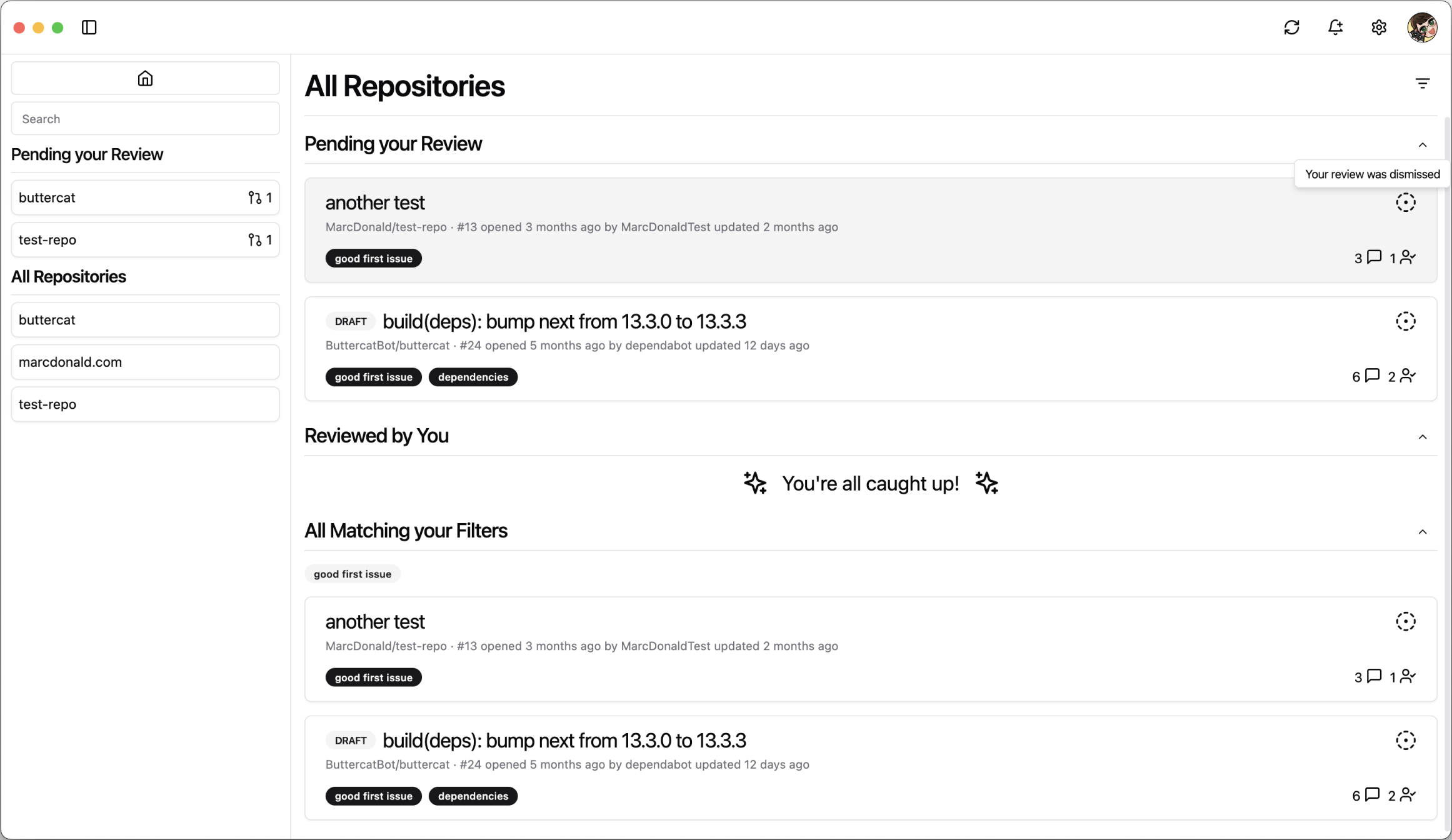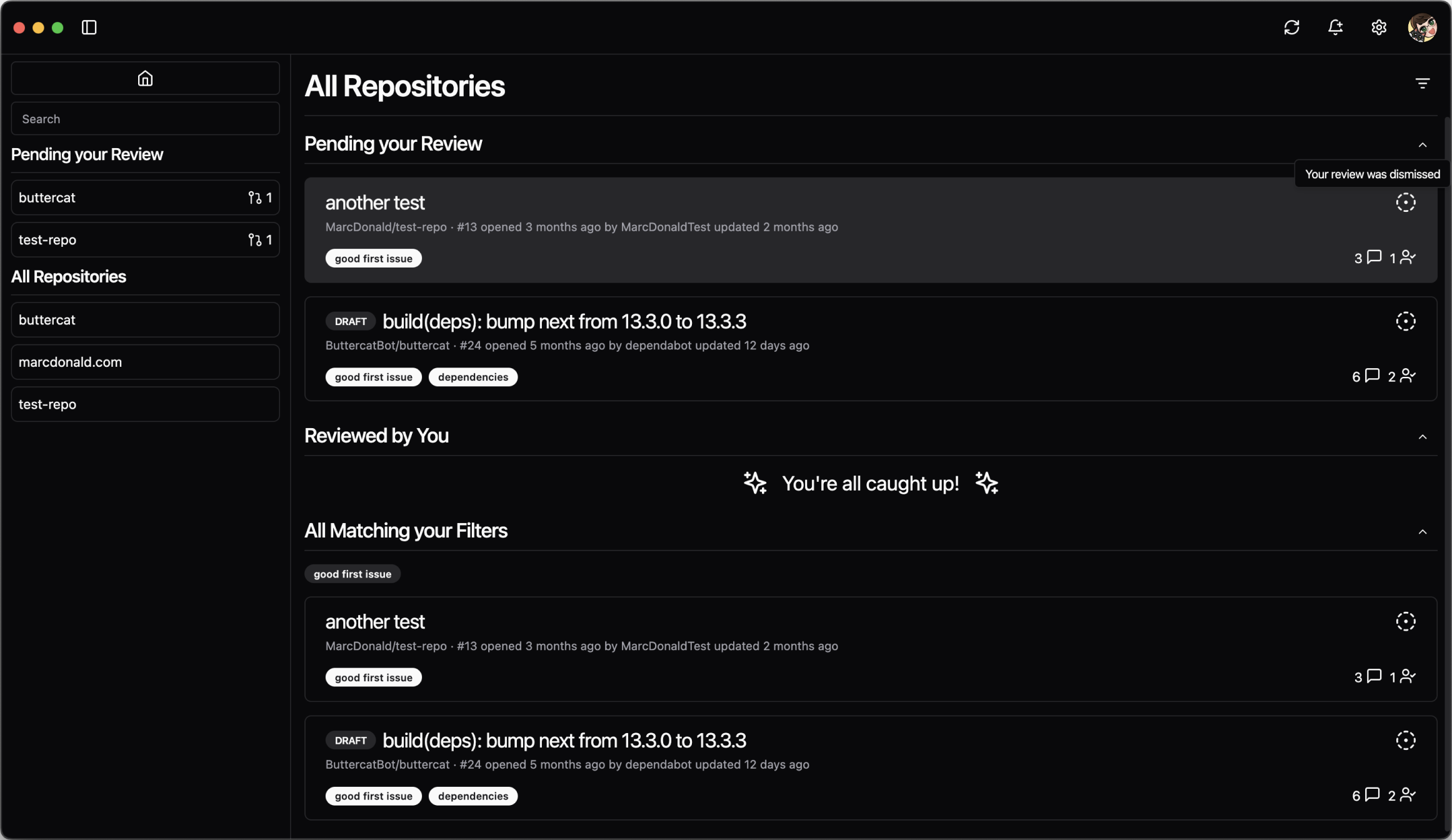From PR Pandemonium to PR Paradise
Published: 1 October 2023
Last Modified: 5 October 2023
PR Pandemonium
If you're a developer in a large company you've no doubt experienced the pain that comes with being a code-owner for many repositories. The seemingly never-ending pile of PRs across 20 or 30 repositories that you have to sift through to find ones that are time-sensitive. PRs that make you think you're going insane because you swear you've seen these exact changes before, only to realise that you have reviewed this PR before and your review was dismissed because of typo fix or a version bump commit.
These issues are made exponentially worse when your team starts sharing repositories with other teams, adding the extra step of having to filter through the PRs to find ones that are relevant to your immediate team.
This takes a significant chunk of time and energy, and let's be honest no-one signed up for this amount of admin when they applied to be a Software Engineer.
I knew there had to be a way to alleviate some of this burden. My team had already started to use the GitHub label feature so we could automatically send relevant PRs directly to a Slack channel - but I found that this alone wasn't enough. I was still clicking into PRs constantly to see if I had approved them in the past, and I was still missing PRs from my team resulting in them having to message me asking me to take a look.
Goldilocks and The Three Requirements
I spent some time researching solutions and trying some existing third party tools to see if any could satisfy my three requirements:
- Real-time (or pretty close) desktop notifications
- Filtering by label + repository
- PRs shouldn't vanish when a teammate reviews it or my existing review is dismissed
Alas, I found none that managed to meet all three. The closest I could find was Gitify, however it lacked features like review dismissal notifications and label filtering.
After several months of trying different tools and techniques I decided whip up a quick tool to meet my requirements.
The Plan? Make a quick tool to notify me of PRs that need my attention.
The Reality? Spend 3 months of my life creating an app that met my potentially very niche needs.
The World Could Always Use More Electron Apps
I have a confession to make.
I'm a zoomer.
My favourite language is TypeScript and I mainly work in the React/AWS sphere. I've looked at Swift before in the past but never in any detail, and I didn't really want to learn another language and platform just for this quick app. I'm also a big IntelliJ stan and in my limited time trying out XCode I had precisely zero desire to use it for an actual project.
I decided to risk my public standing and write an Electron app. I know, I know, how could I do such a thing? Electron apps are slow, massively inefficient, and don't integrate with the OS nicely!
I'm going to be honest - I prioritised the developer experience here. As I said, I'm a React dev. I have experience writing webapps, and this was just going to be a quick app I hoped to churn out in a week or two. I also figured the target audience for this app would be enterprise developers with decently powerful MacBooks - hyper-optimised performance wasn't really that big a concern (as long as it didn't slow my Mac to a crawl).
After about three weeks of building a bit every evening after work, I had something that met my initial three requirements. But why stop there? I added a few more nice-to-have features and cleaned up the UI and codebase as I went. Before I knew it, it had been three months and I had an actually pretty nice looking (thanks shadcn!) and stable app.
A Real Product
Outside of my actual day-to-day work I had never made a real product that could be used by random people I've never met. This left me with quite a few questions:
- How can I ensure it's accessible for everyone?
- How do I keep people's information secure?
- How do I distribute it?
- How do I justify spending £80 on an Apple Developer account so I stop getting that bloody security popup?
- How do I tell people about it?
- What should I call it?
During development I had used the name Git Omniscience since the goal was to let you have awareness and understanding of all GitHub PRs that are relevant to you. I thought this name was pretty good so I just dropped the "Git" from the start of it and called the app Omniscience.
Accessibility
I've always been a big proponent of ensuring apps are accessible to everyone, so I put my money where my mouth is and spent several days going through and ensuring everything was up to snuff.
- I added "Skip to Content" links to make keyboard navigation a breeze.
- I made sure I used appropriate semantic HTML elements and alt-text where appropriate.
- In my pre-release testing I used the app with just a screen-reader and my keyboard to check that everything was covered
Security
Security was a big concern of mine. Companies don't tend to like it when you give confidential information out to random applications on the internet. Because of this I opted to use the GitHub Personal Access Token system for authenticating a user. This means that at no point do actual login credentials get input into my app. This also allows the user to scope the token to things like "repo" and "read:user", rather than giving the app the ability to do anything it wanted with your account.
All interactions with GitHub through Omniscience use HTTPS and only use the official GitHub API (no scraping or anything like that!).
Distribution
I debated quite a bit about how best to distribute the app. Since I wasn't planning to open source it, I thought people would be hesitant to download a random binary from a website and give it access to their GitHub account. I also know that some companies don't allow their employees to install unverified software off the internet.
This combined with the fact that some VPNs block new domains or domains with non-standard TLDs meant that downloading a DMG file may not be a good solution for the majority of users. Even if a user just had to selected "Yes I'm fine with going to this site" in order to download the DMG, this would mean auto-updates wouldn't work as the app would not be able to get past this.
In the end I decided to bite the bullet and pay £80 for an Apple Developer license to let people download it via the App Store, as well as to get proper signatures and notarization set up. I had heard that Apple are pretty strict with their App Review process to get on the App Store, but to my surprise I was only rejected twice before succeeding!
Since some companies don't allow their employees to log in to iCloud accounts, I also included the ability to download the DMG from the website. This may change in the future if I decide to add any features that go behind a paywall (don't worry, nothing scummy, all the features in the app at the moment will remain free) but for now both options are available.
PR Paradise
I started working on this app in June 2023 and just released version 1.0.0 last week (September 2023). It took a bit longer than I expected but I'm pretty damn proud of how it turned out!
You can try it out for yourself at omniscience.app or on the App Store.

A screenshot of Omniscience demonstrating some of the key features of the app such as review dismissal notifications, label filtering, and a Pending your Review section
